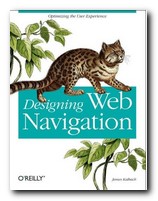optimising the user experience
Anyone who has ever designed a web site will know that navigation of its contents is a key issue in the site’s usability. Visitors must be able to find their way around – otherwise they’ll leave, and they won’t come back again. Successful navigation systems require good screen design, well thought out information architecture, clear labelling, logical hierarchies, and effective linking. This book deals with all these issues of designing web navigation in an extremely thorough manner.
 Every aspect of navigational design is examined in close detail – through both theoretical models and technical research, and a practical examination of a wide variety of large scale web sites from around the world. It’s a beautifully presented book, with elegantly designed pages, full colour illustrations, and scholarly yet unobtrusive footnotes leading to web references and recommendations for further reading.
Every aspect of navigational design is examined in close detail – through both theoretical models and technical research, and a practical examination of a wide variety of large scale web sites from around the world. It’s a beautifully presented book, with elegantly designed pages, full colour illustrations, and scholarly yet unobtrusive footnotes leading to web references and recommendations for further reading.
The chapters are almost exhaustively thorough. On navigation mechanisms for instance, he covers every possibility – from tabs to breadcrumb trails, and from dropdown menus to sitemaps, tag clouds, A to Z indexes, and star trees. You couldn’t wish for anything more comprehensive. He discusses the advantages and the potential disadvantages of each system, showing examples of where they are used to good effect.
Although it is primarily concerned with the delivery of content over the Web and read in browsers on a computer, he also discusses the navigational consequences of content delivery via mobile phones, personal digital assistants (PDAs) and even car navigation systems.
On the issue of designing a navigation system he has a very sound piece of advice. “Don’t start by designing the navigation on the home page.” This might seem counter-intuitive, because for most designers the home page is the focus of their attention, and it’s the root, the index page of the entire site. But it’s not the most important page for visitors. Most of them will enter via a page deep within the site to which they have been referred by a link from a search engine.
Although there’s quite a lot on extensive usability testing, in general he strikes a reasonable balance between writing for professional designers of large scale corporate and ecommerce sites, and smaller sites which might be the work of an individual entrepreneur. There are certainly plenty of tips on the presentation of text on a page for instance which could help improve the work of an enthusiastic amateur.
He ends by discussing the relationship between navigation and searching, social tagging systems, and rich web applications. These latter post a new challenge to designers, because web pages are no longer static entities which appear in the order they are summoned via mouse clicks. Rich web applications can compose the content of a web page dynamically. Once the user has chosen a new set of data on screen, there is nowhere to go back to. The page URL remains the same, even though what is being displayed has changed. Fortunately, he provides ample guidance to designers on how to cope with such new problems.
I think this is a book which aspires to position itself alongside Louis Rosenfeld and Peter Morville’s Information Architecture for the World Wide Web and Jakob Nielsen’s Homepage Usability as modern classics of web design principles.
© Roy Johnson 2007
James Kalbach, Designing Web Navigation, Sebastopol (CA): O’Reilly, 2007, pp.394, ISBN: 0596528108
More on information design
More on design
More on media
More on web design